It’s that time of the year again. SwimSwam will be previewing the top 12 men’s and women’s teams (and then some) from the 2022 NCAA Championships. Follow along with the College Swimming Preview Channel. Want to read even more? Check out the latest edition of the SwimSwam magazine.
#2 Texas Longhorns
Key Losses: Evie Pfeifer (29 NCAA points, 1 relay), Julia Cook (3 NCAA points, 1 relay)
Key Additions: #3 Lydia Jacoby (breast), graduate transfer Dakota Luther (fly)
GRADING CRITERIA
Two years ago, we unveiled a new, more data-based grading criteria based on ‘projected returning points’, a stat of our own making that involved a lot of manual calculations involving departing seniors, redshirts, freshmen, etc. We liked the objectiveness of that stat, but given that there’s still a lot of uncertainty for this year, we’re adopting a hybrid approach this year. The “stars” will rely heavily on what swimmers actually did last year, but we’ll also give credit to returning swimmers or freshmen who have times that would have scored last year.
Since we only profile the top 12 teams in this format, our grades are designed with that range in mind. In the grand scheme of college swimming and compared to all other college programs, top 12 NCAA programs would pretty much all grade well across the board. But in the interest of making these previews informative, our grading scale is tough – designed to show the tiers between the good stroke groups, the great ones, and the 2015 Texas fly group types.
- 5 star (★★★★★) – a rare, elite NCAA group projected to score 25+ points per event
- 4 star (★★★★) – a very, very good NCAA group projected to score 15-24 points per event
- 3 star (★★★) – a good NCAA group projected to score 5-14 points per event
- 2 star (★★) – a solid NCAA group projected to score 1-4 points per event
- 1 star (★) – an NCAA group that is projected to score no points per event, though that doesn’t mean it’s without potential scorers – they’ll just need to leapfrog some swimmers ahead of them to do it
We’ll grade each event discipline: sprint free (which we define to include all the relay-distance freestyle events, so 50, 100 and 200), distance free, IM, breaststroke, backstroke, butterfly and diving. Use these grades as a jumping-off point for discussion, rather than a reason to be angry.
2021-2022 LOOKBACK
The Texas women held the fourth spot in the SwimSwam power rankings for the majority of last season. Then, in our final rankings, we had them at third, trailing only Virginia and Stanford. Much of the conversation heading into the 2022 NCAAs centered around whether there was anything Stanford could do to beat Virginia. In hindsight, the conversation should have been about the battle between Stanford and Texas for second.
Stanford didn’t swim badly, but both Texas’ swimmers and divers performed exceptionally. They raked in points from Kelly Pash‘s three ‘A’ finals, Anna Elendt‘s strong finishes in breaststroke, and the distance duo of Erica Sullivan and Evie Pfeifer. However, it was their butterfly and diving that powered them past Stanford in the final individual events of the meet—200 fly and platform. Then, they did enough in the 400 free relay to hold off Stanford, securing their place as the national runner-up.
After an exceptional meet like that, can the Longhorn women hold onto their momentum and defend their spot as the country’s #2?
Sprint Freestyle: ★★
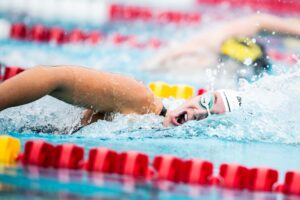
Kyla Leibel (photo: Jack Spitser)
While the Texas women have many areas where they shine, sprint freestyle is not one of them. They had just one woman compete in either the 50 or 100 freestyle at NCAAs—Emma Sticklen, who finished 33rd in the 50 freestyle in 22.26. While that was just off her lifetime best, it took 21.99 to make it back for finals last year. With no recruits coming in who will immediately contribute NCAA points in the 50 or 100 free, it looks like this area will still be a gap for Texas in the 2022-23 season.
At the dual meet and conference level, however, they have more depth. With a 22.07, it was then-sophomore Grace Cooper who had Texas’ fastest time in the 50 freestyle last season. Cooper is the two-time Big-12 champion in the event, and will make a run at the hat trick this season. She’s not as strong in the 100 freestyle—her best time is 49.00—but she still finished fifth at Big 12s. That 49.00 came from the Minnesota Invitational, and she added more than half a second en route to her Big-12 title. To make even more of an impact in the postseason, she’ll need to aim to be at her best come February.
Texas kept Sienna Schellenger in-state, and she holds lifetime bests of 22.76 in the 50 and 49.73 in the 100. While neither of those will make an immediate impact, she could be a key relay piece for the Longhorns.
Seniors Bridget Semenuk and Kyla Leibel are classic 50/100/200 freestylers and—especially Leibel—the further they go the better they get. Both played crucial roles on the Texas relays all season, and are important depth pieces as the Longhorns look to hold on to their second place in the team competition. None of Semenuk, Leibel or Cooper swam an individual event at NCAAs last season. Relays are a weak spot for Texas, so continued improvement will be paramount for this trio will be paramount this season, especially as Texas has a few key legs to replace.
Their best 200 freestyler is Kelly Pash, who finished third at NCAAs with a lifetime best 1:42.38. Pash had a strong long course season and should bring that momentum into her senior campaign. 200 free national champion Taylor Ruck does return and showed herself to be back on form last season, when she won in 1:41.12. Given that, it might take a big lifetime best for Pash to win an individual national title, but that isn’t impossible.
Distance Freestyle: ★★★★
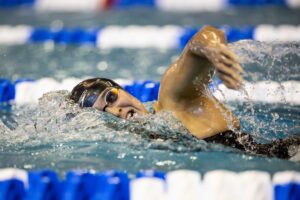
Erica Sullivan (photo: Jack Spitser)
Tokyo Olympian Erica Sullivan headlines the Longhorns’ 2022-2023 distance group. As a freshman last year, Sullivan finished third in the 500 (4:35.92) and second in the 1650 (15:45.94) at NCAAs, amassing 33 individual points. Her personal bests in both events were set prior to her freshman year, so we know that her ceiling is higher. That’s especially true in the mile, where her time was over 22 seconds off her 15:23.81 lifetime best. Sullivan had a shoulder injury in the offseason, which caused her to miss U.S. World Trials in April. Since then, she swam one event at U.S. Nationals, where she placed fourth in both the 800 and 1500 meter freestyles.
Evie Pfeifer scored 27 points across the same events last year and has since graduated, which is a big loss for the Longhorns. It leaves Sullivan as the sole scorer for Texas in the distance events, with questions still lingering about what kind of form she’s bringing into the season and her recovery. Sullivan is certainly capable of holding her place in the event standings—and if she’s on form winning both or either—but as it stands, the Longhorns will lose points from 2022 to 2023 NCAAs in these events. What they really need is another distance swimmer having a big season and jumping up into NCAA scoring.
Even with the loss of Pfeifer, Sullivan alone makes this a four-star distance group.
Backstroke: ★★★
It’s junior backstroker/butterflier Olivia Bray who leads the Longhorns’ backstroke group this season.
Last year at NCAAs, she took on the 100 fly/100 back double, and in the 100 back, finished eighth in 51.02 after posting a personal best of 50.69 in prelims. She opted for the 200 fly last year at NCAAs, so those 11 points were the only ones Texas scored in the 100 back. She did race the 200 back at Big 12s, where she went a personal best of 1:51.09, which would have earned her seventh at NCAAs. After posting multiple lifetime bests last season, Bray comes into this season with a strong foundation to build off as she continues to improve.
Given Texas’ depth in the 200 fly, which is also getting a significant improvement this season (more on that below), it’s possible we see Bray take on the 200 back over the 200 fly in 2023.
The backstroke group has lost Julia Cook, who was an important depth piece for the Longhorns. They’re bringing in two freshmen, Meghan DiMartile and Emily Carpenter, who are both 1:58-high in the 200. Neither project to make an immediate impact this season, but could develop into important pieces.
Breaststroke: ★★★★
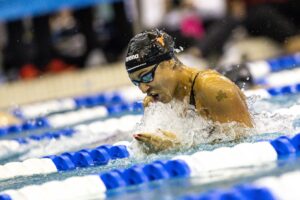
Anna Elendt (photo: Jack Spitser)
Last season, German Olympian Anna Elendt had a major breakthrough in yards. She first made headlines by breaking Texas’ 100-yard breaststroke school record in December 2021. At the Big 12 Championships, she split a blistering 56.42 on the 400 medley relay. Then, at NCAAs, she roared to 56.88 in prelims of the 100 breast, joining an exclusive group of women under 57 seconds as the fifth-fastest all-time. She added time in the final, ultimately finishing fifth in a razor-thin race, though her morning time would have won the event. She followed that up by clocking 2:04.31 in the 200 breast, finishing second behind Kate Douglass‘ American record performance.
Elendt made great strides in her sophomore season, and now as a junior will be counted on for her consistency as one of the best breaststrokers in the NCAA. Her 56.88 100-yard time makes her a serious contender for the national title, especially with Alexis Wenger (UVA) and Sophie Hansson (NC State) graduating. In the 200 breast, it’s hard to see her beating Douglass, but she should remain near the top of the podium. It’s realistic to expect Elendt to equal or surpass the 31 NCAA points she contributed last season.
The Longhorns are also getting an incredible addition to their breaststroke group in Lydia Jacoby. The Tokyo gold medalist in the 100-meter breaststroke, Jacoby also has the fastest time in her class in yards with a 58.87. Jacoby went from unranked as a sophomore, to eighth as a junior, to #3 on our re-rank of the girls’ high school class of 2022. Even though her yards times aren’t yet at the same level as her long course pedigree, she’s made big improvements and should continue to do so at Texas. She and Elendt will be a lethal duo to contend with. We’ll get more in-depth on relays later, but right now it looks like Elendt retains her spot on the medleys, though Jacoby could very well challenge her.
Butterfly: ★★★★★
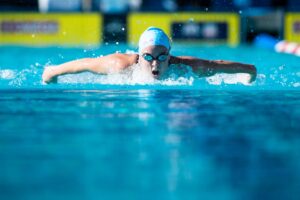
Dakota Luther (photo: Jack Spitser)
The days of the Texas butterfly group have come again, and this time it’s the women’s team that has perhaps the best fly corps in the country. At the 2022 NCAAs, they scored the most points of any team in both individual butterfly events, racking up 27 points in the 100 and 37 in the 200.
It was their three 200 fly ‘A’ finalists (Pash, Bray, and Sticklen) who launched them into a position to pass Stanford for second place in the team standings in the final events of the meet. The three finished fifth, seventh, and eighth in that final, respectively, with Pash the fastest of the three in 1:52.01. Sticklen popped 1:51.45 in prelims, which would have put her third if she’d repeated that time in finals. Though they will be pushed by the likes of Charlotte Hook, Lillie Nordmann, and Lindsay Looney, it’s still realistic to expect them all to return to the ‘A’ final, especially with Olivia Carter and Regan Smith‘s departures from the NCAA.
If it wasn’t enough that Pash, Bray, and Sticklen all return, the Longhorns are also adding Dakota Luther as a graduate transfer to their already formidable group. With Luther now at Texas, it’s a real possibility that we could see a 200 fly ‘A’ final at 2023 NCAAs with half of the swimmers sporting Longhorn caps. Factoring in Luther’s fourth-place finish in the 200 fly (just ahead of Pash), that would have brought their total points in the event to a whopping 52 last season. She also adds depth in the 100 fly, where she finished 11th at NCAAs in 51.01.
Simply put, this is a group that will bring in a major haul of points for Texas. With the 200 butterfly being the final individual swimming event of NCAAs, the value of Texas’ fly group is incredibly high. While Virginia will likely have clinched their third title in a row by that point, this group of athletes makes it so that any team wishing to finish second will have to accumulate a huge lead on the Longhorns to beat their fly group (and their divers) in the waning events of the meet.
IM: ★★
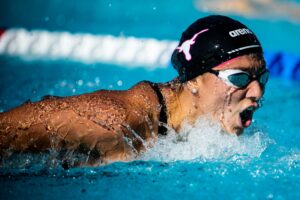
Kelly Pash (photo: Jack Spitser)
For Texas, the IMs are similar to sprint freestyle in that Pash is their only NCAA scorer. She finished fifth in the 200 IM at NCAAs, hitting a lifetime best of 1:53.31. Pash was the only Longhorn entered in the event, and as seven of the ‘A’ finalists (potentially eght, depending on how Izzy Ivey’s eligibility works out) return, it projects as a quite crowded event. It’s also Luther’s third event, and she finished 24th last year in 1:56.67. It took 1:55.90 to final last year, which would be a significant, but not impossible drop for Luther.
In the 400 IM, the Longhorns had no NCAA scorers. Pash had the fastest time of the season with a 4:07.65 to win Big 12s, but don’t expect her to race it at NCAAs. With Pfeifer, who did swim the event at NCAAs (19th, 4:08.76), graduated, the next fastest woman on the roster is sophomore Olivia McMurray, who holds a lifetime best of 4:13.67 and is primarily a distance freestyler.
None of their recruits are medley specialists either, and with IM being the third event for those on the roster who do swim it, it looks like it will remain a discipline where Texas won’t pick up many NCAA points.
Diving: ★★★★★
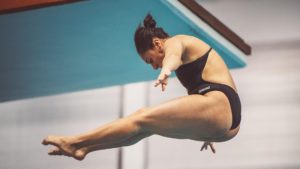
Paola Pineda courtesy Texas Athletics
By the parameters we set in our grading criteria, Texas diving earns four stars because they “only” scored 17 points on the 1-meter board at NCAAs. However, compared to the other teams vying for top spots in the division, they are worthy of five stars. Those 17 points were the only points that a top ten team scored on the 1-meter.
And they got better on the higher boards. Hailey Hernandez and Paola Pineda scored on 1-meter by finishing fourth and 15th, respectively. They both ‘A’ finaled on 3-meter, with Pineda finishing sixth and Hernandez eighth. They were joined in the final by Jordan Skilken, who earned 10th, bringing their total points in the event to 31. Then, in platform diving on the last day of the meet, Skilken and Pineda took third and eighth, with junior Janie Boyle earning fourth. Together, they accumulated 42 points and pushed Texas ahead of Stanford for second in the team race.
All four of these high-powered divers return to Texas for the 2022-2023 season, giving Texas a huge edge in the race for second, as none of the other top five teams are within range of equaling Texas’ diving points. In addition, they also add Canada’s Sarah Carruthers, who joins the team as a freshman this year.
It’s hard to overstate the value that this group brings to the Longhorns, especially given that they all have the capacity to improve on their finishes from last season. We mentioned this in the butterfly section, but the 200 fly and platform finals being the final two individual events of the meet is a lethal back-to-back for Texas—one that keeps them dangerous through the whole competition, and covers most of the gaps they have.
Relays: ★★★
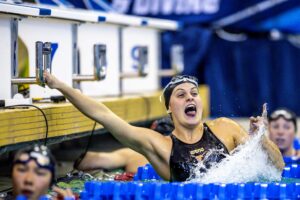
Emma Sticklen (photo: Jack Spitser)
One of those gaps is their relays. Compared to the other top teams, this is a major weakness for the Longhorns, though it’s not a surprising one. Given their lack of depth in sprint freestyle, it’s not shocking that only three of their relays made the top eight last year. The only free relay to crack that barrier was the 800, which finished fourth in 6:56.21. They lose their 1:44.29 anchor, Pfeifer, but return the other three legs: Pash, Bray, and Leibel.
The other two “‘A’ final” relays were the medleys with the 200 finishing fifth and the 400 fourth. While the entire 400 medley relay (Bray, Elendt, Sticklen, and Pash) returns this year, they will need to replace Julia Cook as the sprint backstroker on the 200 medley. Last year, that was the relay they opted to not use the versatile Pash on: Bray split 22.56 on fly and Sticklen anchored in 21.69. That was just .04 off what Pash split on the 200 free relay, so that decision made sense in 2022.
But will it still make sense in 2023? There are a variety of options for the Longhorns: if the plan is to keep Pash off the relay, they could move Bray to backstroke, then put Sticklen on fly and replace her free leg with Cooper, Semenuk, or Schellenger, depending on how they develop this year. If they want to put Pash on the relay, and “punt” on the 200 free relay, then that’s an easy switch too and Schellenger (or potentially Leibel) would likely draw on to that relay instead.
If you’re wondering how Luther factors into relay decisions, last year she split a 23.37 50 fly and 51.28 100 fly, both slower than Texas’ butterfly legs on the medley relays. Hr 50 fly split is over half a second slower than Bray’s, therefore, her presence on the Texas roster likely won’t sway any relay decisions at this point.
Total Stars: 28/40
2022-2023 Outlook:
The Texas Longhorns are getting two massive additions in Olympic champion Jacoby and 200-meter fly national champion Luther. Paired with a core of returning star swimmers and divers, that sets Texas up for another strong season. While they don’t have enough depth to overcome the Virginia Cavaliers, they should be able to hold onto the runner-up team trophy.
They’ll have a good battle for that position with Stanford though, and ultimately, who you think earns second comes down to which duo you believe will have more of an impact: Jacoby/Luther or Curzan/Hook. Here at SwimSwam, we’re going with Jacoby, Luther, and the Longhorns to retain their spot.
WOMEN’S PREVIEW INDEX
| Team | Sprint Free | Distance Free | Backstroke | Breaststroke | Butterfly | IM | Diving | Relays | Total Stars |
| 1 | |||||||||
| #2 Texas Longhorns | ★★ | ★★★★ | ★★★ | ★★★★ | ★★★★★ | ★★ | ★★★★★ | ★★★ | 28/40 |
| #3 Stanford Cardinal | ★★★★ | ★★★ | ★★★★★ | ★★ | ★★★★★ | ★★★ | ★ | ★★★★★ | 28/40 |
| #4 Alabama Crimson Tide | ★★★★★ | ★★★ | ★★★★ | ★★★ | ★★ | ★ | ★ | ★★★★ | 23/40 |
| #5 NC State Wolfpack | ★★★★ | ★ | ★★★★ | ★★★ | ★★★ | ★★ | ★ | ★★★★ | 22/40 |
| #6 Louisville Cardinals | ★★★ | ★★★ | ★★ | ★ | ★★★★ | ★★★ | ★★ | ★★★★ | 22/40 |
| #7 Michigan Wolverines | ★★★ | ★★ | ★ | ★★ | ★ | ★★ | ★ | ★★★ | 15/40 |
| #8 California Golden Bears | ★ | ★ | ★★★ | ★ | ★★★ | ★★★ | ★ | ★★★ | 16/40 |
| #9 Ohio State Buckeyes | ★★★ | ★★★ | ★★ | ★★★ | ★★ | ★★ | ★★★ | ★★★★ | 22/40 |
| #10 Tennessee Volunteers | ★★★ | ★★★★ | ★★★ | ★★★ | ★★★ | ★★★★ | ★ | ★★★ | 24/40 |
| #11 Indiana Hoosiers | ★★ | ★★ | ★ | ★★★ | ★ | ★★ | ★★★★ | ★ | 16/40 |
| #12 Kentucky Wildcats | ★ | ★ | ★★ | ★★★ | ★★ | ★★★ | ★★ | ★★ | 16/40 |

Erica Sullivan did not have shoulder surgery. She had a shoulder injury. Jeez
Enjoy seeing videos of this team – they seem to really enjoy being with each other and it is translating into results in the pool.
With the addition of Jacoby, Texas breaststroke is going to be elite, ☆☆☆☆☆!
Thanks for mentioning the Longhorn divers. Their contribution was huge!
Actually, they are bringing in 3 freshman with 1:58 2BKs, Davison.